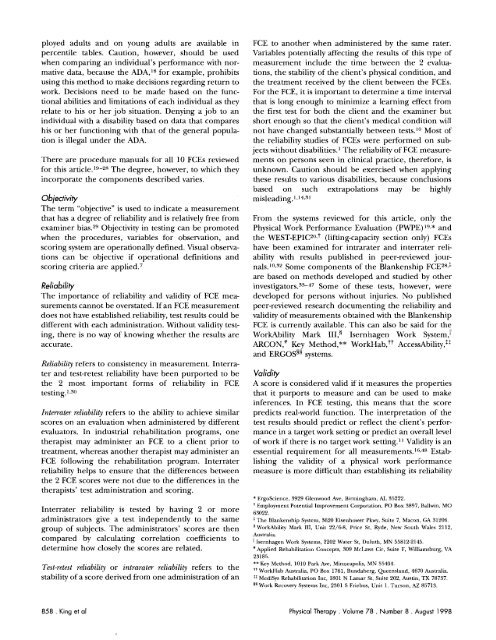A Critical Review of Functional Capacity ... - Physical Therapy
A Critical Review of Functional Capacity ... - Physical Therapy
A Critical Review of Functional Capacity ... - Physical Therapy
Create successful ePaper yourself
Turn your PDF publications into a flip-book with our unique Google optimized e-Paper software.
ployed adults and on young adults are available in<br />
percentile tables. Caution, however, should be used<br />
when comparing an individual's performance with nor-<br />
mative data, because the ADA,18 for example, prohibits<br />
using this method to make decisions regarding return to<br />
work. Decisions need to be made based on the func-<br />
tional abilities and limitations <strong>of</strong> each individual as they<br />
relate to his or her job situation. Denying a job to an<br />
individual with a disability based on data that compares<br />
his or her functioning with that <strong>of</strong> the general popula-<br />
tion is illegal under the ADA.<br />
There are procedure manuals for all 10 FCEs reviewed<br />
for this article.lSm The degree, however, to which they<br />
incorporate the components described varies.<br />
Objectivity<br />
The term "objective" is used to indicate a measurement<br />
that has a degree <strong>of</strong> reliability and is relatively free from<br />
examiner bias.2Wbjectivity in testing can be promoted<br />
when the procedures, variables for obsernation, and<br />
scoring system are operationally defined. Visual observa-<br />
tions can be objective if operational definitions and<br />
scoring criteria are a~plied.~<br />
Reliability<br />
The importance <strong>of</strong> reliability and validity <strong>of</strong> FCE mea-<br />
surements cannot be overstated. If an FCE measurement<br />
does not have established reliability, test results could be<br />
different with each administration. Without validity test-<br />
ing, there is no way <strong>of</strong> knowing whether the results are<br />
accurate.<br />
Reliability refers to consistency in measurement. Interra-<br />
ter and test-retest reliability have been purported to be<br />
the 2 most important forms <strong>of</strong> reliability in FCE<br />
testing.<br />
Intewater reliability refers to the ability to achieve similar<br />
scores on an evaluation when administered by different<br />
evaluators. In industrial rehabilitation programs, one<br />
therapist may administer an FCE to a client prior to<br />
treatment, whereas another therapist may administer an<br />
FCE following the rehabilitation program. Interrater<br />
reliability helps to ensure that the differences between<br />
the 2 FCE scores were not due to the differences in the<br />
therapists' test administration and scoring.<br />
Interrater reliability is tested by having 2 or more<br />
administrators give a test independently to the same<br />
group <strong>of</strong> subjects. The administrators' scores are then<br />
compared by calculating correlation coefficients to<br />
determine how closely the scores are related.<br />
Test-retest reliability or intrarater reliability refers to the<br />
stability <strong>of</strong> a score derived from one administration <strong>of</strong> an<br />
FCE to another when administered by the same rater.<br />
Variables potentially affecting the results <strong>of</strong> this type <strong>of</strong><br />
measurement include the time between the 2 evalua-<br />
tions, the stability <strong>of</strong> the client's physical condition, and<br />
the treatment received by the client between the FCEs.<br />
For the FCE, it is important to determine a time internal<br />
that is long enough to minimize a learning effect from<br />
the first test for both the client and the examiner but<br />
short enough so that the client's medical condition will<br />
not have changed substantially between tests.1° Most <strong>of</strong><br />
the reliability studies <strong>of</strong> FCEs were performed on sub-<br />
jects without disabilities.] The reliability <strong>of</strong> FCE measure-<br />
ments on persons seen in clinical practice, therefore, is<br />
unknown. Caution should be exercised when applying<br />
these results to various disabilities, because conclusions<br />
based on such extrapolations may be highly<br />
mi~leading.l,~4.~~<br />
From the systems reviewed for this article, only the<br />
<strong>Physical</strong> Work Performance Evaluation (PWPE) and<br />
the WEST-EPIC~~.~ (lifting-capacity section only) FCEs<br />
have been examined for intrarater and interrater reliability<br />
with results published in peer-reviewed journal~.~"~~<br />
Some components <strong>of</strong> the Blankenship FCE'";<br />
are based on methods developed and studied by other<br />
investigators.3s47 Some <strong>of</strong> these tests, however, were<br />
developed for persons without injuries. No published<br />
peer-reviewed research documenting the reliability and<br />
validity <strong>of</strong> measurements obtained with the Blankenship<br />
FCE is currently available. This can also be said for the<br />
WorkAbility Mark 111,~ Isernhagen Work<br />
ARCON,' Key Method,** ~ork~ab,~~ ~ccess~bilit~,::<br />
and ERGOS~~ systems.<br />
Validity<br />
A score is considered valid if it measures the properties<br />
that it purports to measure and can be used to make<br />
inferences. In FCE testing, this means that the score<br />
predicts real-world function. The interpretation <strong>of</strong> the<br />
test results should predict or reflect the client's perfor-<br />
mance in a target work setting or predict an overall level<br />
<strong>of</strong> work if there is no target work setting.ll Validity is an<br />
essential requirement for all measurements.16.48 Estab-<br />
lishing the validity <strong>of</strong> a physical work performance<br />
measure is more difficult than establishing its reliability<br />
' Ergoscience, 3929 Glenwood Ave, Birmingham, AL 35222.<br />
E~nployrnent Potential Improvement Corporation, PO Box 3897, Aallwin, MO<br />
63022.<br />
The Blankenship System, 3620 Eisenhower Pkwy, Suite 7, Macon, GA 31206,<br />
sWorkAbility Mark 111, Unit 22/68, Price St, Ryde, New South Wales 2112,<br />
Australia.<br />
1 Isernhagen Work Systems, 2202 Water St, Duluth, MN 55812-2145.<br />
'Applied Rehabilitation Concepts, 309 McLaws Cir, Suite F, Williamsburg, VA<br />
23185.<br />
** Key Method, 1010 Park Ave, Minneapolis, MN 55404.<br />
tt WorkHab Australia, PO Box 1761, Bundaherg, Queensland, 4670 Australia.<br />
fr MediSys Rehabilitation Inc, 1801 N Lamar St. Suite 202, Austin, TX 78737.<br />
§$Work Recovery Systerns Inc, 2301 S Friebus, Unit 1, Tucson, AZ 85713.<br />
858 . King et al <strong>Physical</strong> <strong>Therapy</strong> . Volume 78 . Number 8 . August 1998
















